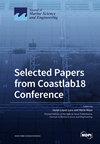不同功率等级之间的水动力相似性以及采用新型滑轮-牵引绳设计的洋流能源转换器-平台系统在不规则台风波浪和洋流中的动态分析
IF 2.8
3区 地球科学
Q1 ENGINEERING, MARINE
引用次数: 0
摘要
未来,商用洋流能转换器的功率将达到兆瓦级,其相应的系泊绳张力也会非常好。然而,目前正在研究的转换器功率仍处于 KW 级,可承受的缆绳张力较小。主缆绳通常为单缆单基。为了研究 MW 级洋流发生器锚泊系统的动态响应和缆绳张力,本文利用白金汉定理提出了(1) 无流体-结构相互作用(FSI)系数和(2) 有流体-结构相互作用(FSI)系数的相似规则。包括这两种情况下的流体动力系数在内的整体流体动力阻力和力矩用泰勒级数表示。假定商用 MW 级和 KW 级洋流转换器之间存在相似性,则 MW 级系统的所有水动力参数均根据已知的 KW 级参数和相似性公式进行估算。为了克服 MW 级系统的极端张力并提供良好的稳定性,本文提出了一种滑绳设计,以取代传统的单牵引绳设计。本文提出了该系泊系统在台风波浪和海流冲击下的静态和动态数学模型,并得到了解析解。我们发现,滑轮绳索设计可显著降低系泊系统的动态绳索张力。主牵引绳 A 绳与海底深度的长度比对稳定转换绳 D 的动态张力影响很大。长度比在安全范围内,最大绳索动张力小于断裂强度。此外,如果钢丝绳长度比超过临界值,则长度比越大,钢丝绳的安全系数越高。总之,滑轮-绳索设计可以安全地用于兆瓦级洋流发生器系统。本文章由计算机程序翻译,如有差异,请以英文原文为准。
The Hydrodynamic Similarity between Different Power Levels and a Dynamic Analysis of Ocean Current Energy Converter–Platform Systems with a Novel Pulley–Traction Rope Design for Irregular Typhoon Waves and Currents
In the future, the power of a commercial ocean current energy convertor will be able to reach the MW class, and its corresponding mooring rope tension will be very good. However, the power of convertors currently being researched is still at the KW class, which can bear less rope tension. The main mooring rope usually has a single cable and a single foundation. To investigate the dynamic response and rope tension of an MW-class ocean current generator mooring system, here, a similarity rule is proposed for (1) coefficients without any fluid–structure interaction (FSI) using the Buckingham theorem and (2) ones with FSI. The overall hydrodynamic drag and moment including the hydrodynamic coefficients in these two situations are represented in a Taylor series. Assuming similarity between the commercial MW-class and KW-class ocean current convertors, all hydrodynamic parameters of the MW-class system are estimated based on the known KW-class parameters and based on the similarity formula. In order to overcome the extreme tension of the MW-class system and to provide good stability, in this paper, we propose a pulley–rope design to replace the traditional single-traction-rope design. The static and dynamic mathematical models of this mooring system subjected to the impact of typhoon waves and currents are proposed, and analytical solutions are obtained. We find that the pulley–rope design can significantly reduce the dynamic rope tensions of the mooring system. The effect of the length ratio of the main traction rope, rope A, to the seabed depth on the dynamic tension of stabilizing converter rope D is significant. The length ratio is within a safe range, and the maximum rope dynamic tension is less than the fracture strength. In addition, if the rope length ratio is over the critical value, the larger the ratio, the higher the safety factor of the rope. In summary, the pulley–rope design can be safely used in an MW-level ocean current generator system.
求助全文
通过发布文献求助,成功后即可免费获取论文全文。
去求助
来源期刊

Journal of Marine Science and Engineering
Engineering-Ocean Engineering
CiteScore
4.40
自引率
20.70%
发文量
1640
审稿时长
18.09 days
期刊介绍:
Journal of Marine Science and Engineering (JMSE; ISSN 2077-1312) is an international, peer-reviewed open access journal which provides an advanced forum for studies related to marine science and engineering. It publishes reviews, research papers and communications. Our aim is to encourage scientists to publish their experimental and theoretical results in as much detail as possible. There is no restriction on the length of the papers. The full experimental details must be provided so that the results can be reproduced. Electronic files and software regarding the full details of the calculation or experimental procedure, if unable to be published in a normal way, can be deposited as supplementary electronic material.
 求助内容:
求助内容: 应助结果提醒方式:
应助结果提醒方式:


